With a backpack strapped like a seasoned trekker, he stops in front of the first suspension bridge, not to enjoy the view. Hiking along exposed cliffs is one thing, but stepping onto a swaying metal structure dangling over the abyss brings hesitation. There’s no loop on the Bisse du Torrent Neuf hike, no shortcut out. He knows: if he conquers the discomfort of crossing now, he’ll have to do it again on the way back. Four footbridges, times two. Eight knee-buckling moments where every hint of a wind gust slices at his legs, and squawking eagles overhead sound like ominous ambassadors of the Leuk Charnel House. Bisse de Savièse is not an ordinary stream-side stroll through the picturesque Swiss Alps. It is a daring challenge that tests the man’s vertigo.
In the cliffs of Prabé Mountain, the daredevil carpenters of the Middle Ages created an impressive irrigation canal known as the Bisse du Torrent Neuf or Bisse de Savièse
While filming another uninterrupted Pipeaway Walk, the suspension bridges of Bisse du Torrent Neuf became stops where I would take a breather, too. As soon as someone stepped onto one, it would rock side to side, messing with my balance as I tried to achieve stable footage. These imposing modern structures, as fascinating as the wooden creations of medieval water tamers they accompany, acted as a hike bottleneck. As I’d wait for them to clear, I would also come face-to-face with him, a young local psyching himself up for his “small step for a man”.
I won’t pretend I’m immune to the creeps of the heights. Walking across a metal grid that lets you peer straight through to the unsettling drop below, putting all your trust in the expertise of the engineers, requires switching off the instinctive fight-or-flight response. Maybe I’m just masking my phobias in the filming-requirement excuse, while I just want a solo moment when those Hitchcockian screeching eagles grab a ride on the air stream.
High above the Rhône Valley, nestled in the cliffs of Prabé Mountain, the daredevil carpenters of the Middle Ages created an impressive irrigation canal known as the Bisse du Torrent Neuf or Bisse de Savièse.
Today, with its restored glory, this meeting point of natural beauty, historical significance, and a hearty dose of adrenaline acts as a hiking trail that takes one’s breath away both metaphorically and literally. Yet somehow, this uniquely Swiss adventure experience still flies under the radar of most tourists.
So, shall we take on the Bisse du Torrent Neuf together? Don’t look down.
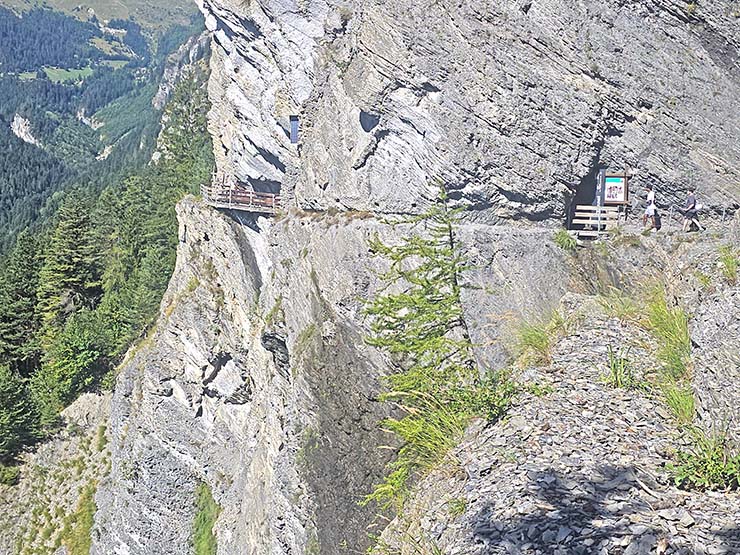
What is the Bisse du Torrent Neuf?
The Bisse du Torrent Neuf is part of a unique network of historic irrigation canals, called bisses, found only in Switzerland’s canton of Valais. The cultural significance of these iconic open-air waterway systems was so high that a bisse image even made it onto the Swiss 100-franc banknote.
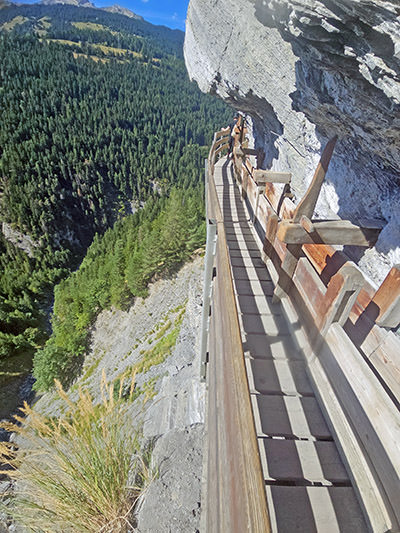
Built in the 15th century, Bisse du Torrent Neuf originally carried water from the Nétage River, and later from the Morge, to the sun-drenched slopes of Savièse, where it was used to irrigate vineyards, orchards, fields, and pastures.
Today, the most daring irrigation project has been reimagined as a hiking trail, with spectacular views of the surrounding cliffs and valleys.
The round-trip hike is just over 8 kilometers long, traversing an altitude between 1.100 and 1.300 meters, and is generally open from May to October, weather permitting.
The Bisse du Torrent Neuf hike is considered easy but dizzy. The trail is safe and accessible even to beginners, but it is not recommended for those with vertigo due to its dramatic cliffside paths.
If you like living on the edge, consider hiking to these famous rocks in Norway!
Bisse du Torrent Neuf history
The history of Bisse du Torrent Neuf begins in the 15th century, when the farmers of Savièse needed a reliable way to transport water to their dry, sunbaked lands. Their solution would become one of the boldest feats of medieval Swiss engineering.
As its name (‘new torrent’) implies, there was an even earlier canal bringing water from the Morge Valley to the Saviésan hillside – Croué Torin (‘bad torrent’, or ‘old torrent’). This one was filling into Étang de Mouchy, a lake sitting at around 1,000 meters in altitude. Gravity has its limits; this bisse couldn’t irrigate the higher areas of Savièse. Other bisses like Tsampé and Déjore, fed by the Sionne River, were already overburdened.
So between 1430 and 1448, the community rolled up its sleeves for a large-scale project – building Bisse du Torrent Neuf, a vital artery for their agriculture.
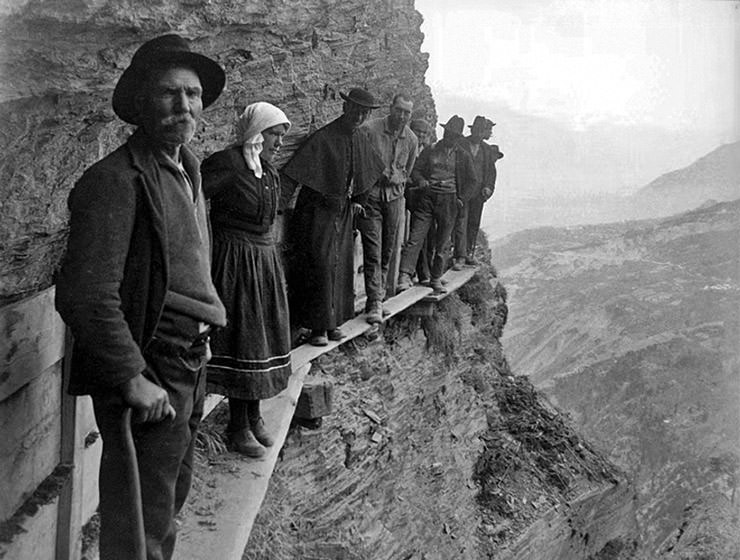
Unlike the gently sloping hillside bisses, this new canal boldly clung to sheer cliffs, supported by wooden structures hundreds of meters above the valley floor. It was a technical marvel of its time. And a dangerous one. Local lore claims that some people even made their confessions before walking certain segments.
The bisse went through several upgrades. In 1550, its route was modified to increase water flow by constructing the famous Wall of the Branlires, where wooden canals were mounted directly onto the rock face. In 1880, the Bisse du Torrent Neuf was extended even further to pull water directly from the Morge River.
To secure a water supply for the entire municipality once and for all, Savièse started digging a tunnel through Prabé Mountain in 1933. The 4.5-kilometer-long water system linking Mayens-de-la-Zour to Tsandra would open in 1935, essentially obliterating Bisse du Torrent Neuf’s importance.
Abandoned and left to decay, much of the wooden scaffolding clinging to the walls of the Prabé crumbled, and the once-essential aqueduct quietly faded into oblivion.
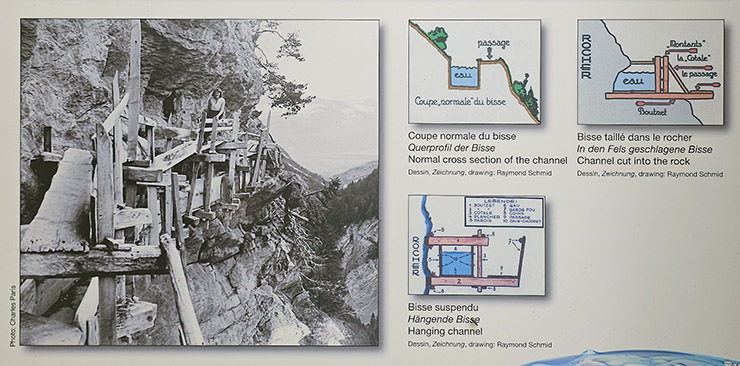
It wasn’t until the early 2000s that local authorities, in cooperation with the Association for the Preservation of the Torrent-Neuf, decided to restore and refill parts of the bisse – not for farmers, but for hikers.
In 2009, after years of careful work, the Bisse du Torrent Neuf was reborn, now featuring four dramatic suspension bridges that made the scenic trail safer and more accessible.
The Swiss mountains are the leitmotif of the Eurovision 2025 in Basel, too. Check it out!
Hiking the Bisse du Torrent Neuf Trail
The hike along the Bisse du Torrent Neuf is a rewarding mix of gentle paths, heart-thumping passages, and dramatic landscapes.
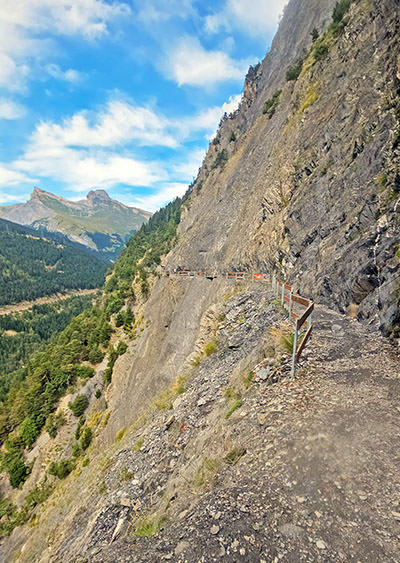
The walk that locals call the Balade du Bisse du Torrent Neuf (not to be confused with the ballad) is an out-and-back trail, typically starting from the Prafirmin area.
The full hike, covering roughly 8 kilometers in total, takes about 3 hours round-trip. Unless you’re stopping every five minutes to mutter “Wow”.
The trail is considered easy to moderate and is mostly flat, following the original route of the bisse. It’s suitable for children, as long as they are sure-footed. A head for heights is essential, as parts of the path hug steep cliff faces. The good news? All exposed sections are protected by sturdy railings, including the spectacular suspension bridges.
Whether you do the full hike or just walk partway to snap a few selfies, the Bisse du Torrent Neuf promises panoramic views, thrilling footbridges, and a tangible connection to centuries of mountain life in Valais.
Bisse du Torrent Neuf Trail Essentials
🥾 Difficulty level: Easy to moderate 📏 Distance: 8.8 km (round trip) 🏔 Altitude: Min 1,125 m / Max 1,265 m 📈 Elevation gain: 140 m ⏱ Duration: ~3 hours 🧭 Trail type: Out-and-back 🚸 Family friendly: Yes (with supervision on cliffside sections) 💰 Entrance fee: Free 👣 Annual visitors: Approx. 100,000 📅 Best time to visit: May 1st - November 1st (closed outside these dates) 🌐 More info: Visit the Bisse du Torrent Neuf official website for current updates
Highlights along the Torrent Neuf trail
What makes the Bisse du Torrent Neuf hike truly unforgettable are the experiences along the way. Sure, the views will drain your camera batteries, but it’s the little surprises, clever engineering, and occasional goat-antelope cameo that elevate this trail from scenic stroll to adventure story.
Suspension bridges
The four suspension bridges along the trail offer a thrilling yet secure way to cross ravines and follow the bisse where the terrain drops away dramatically. Each bridge is about 90 meters long, it tests both your nerves and your ankle strength, and delivers stunning views of the valley and surrounding peaks.
Cliff-carved pathways & tunnel
Sections of the trail are literally chiseled into the rock walls, giving you a firsthand look at the ingenuity of the original stream tamers. There’s also a short tunnel, cut through the mountain to replace a collapsed wooden stretch.
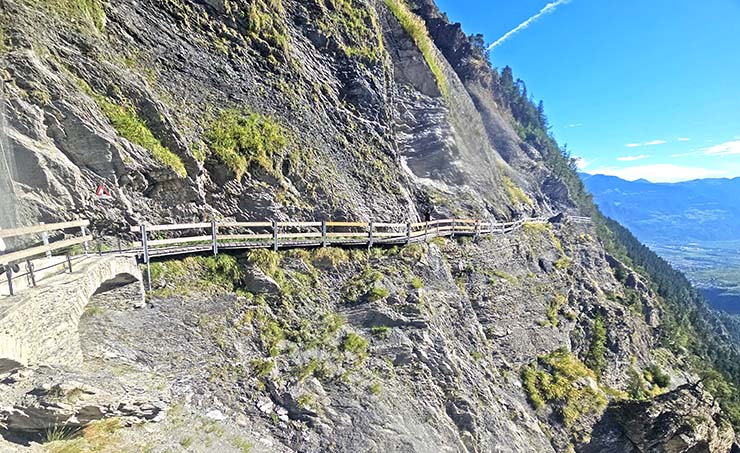
Panoramic viewpoints & wildlife
Several benches and lookouts along the trail make it easy to stop, breathe, and gawk at the majestic scenery. If you’re lucky (and quiet), you might spot a chamois (small but agile goat-antelope), a royal eagle (with a 2.5-meter wingspan), oak jays, marmots, hares, and other alpine wildlife.
Educational signage
Throughout the walk, you’ll find interpretive panels that explain Bisse du Torrent Neuf construction techniques, the distribution of water through the tunnels, and local fauna, existing and extinct. It’s like hiking through a living museum, with a view.
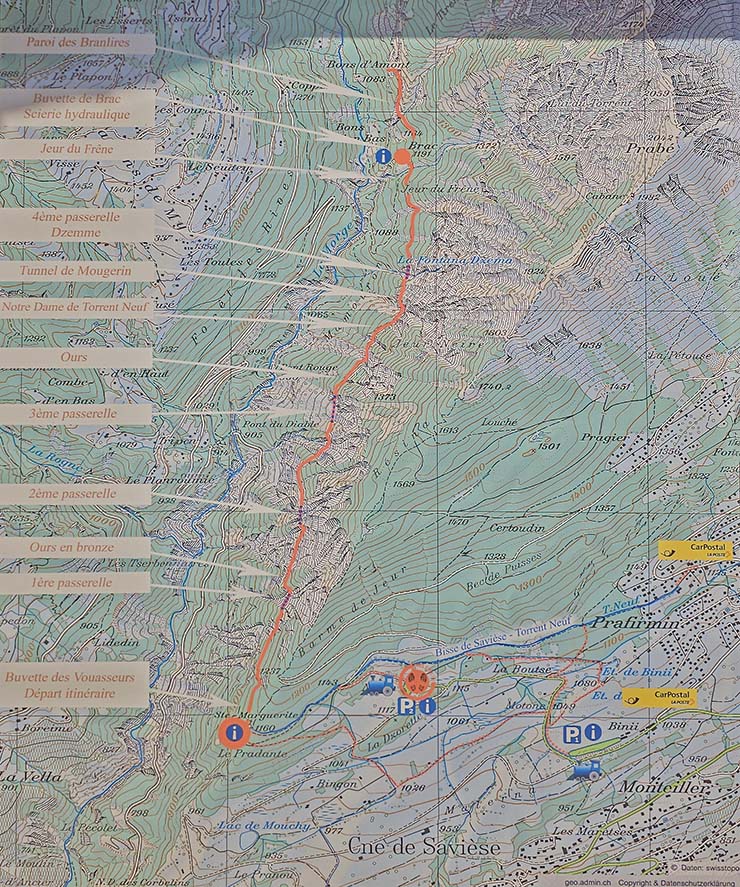
Bisse du Torrent Neuf itinerary – a step-by-step guide
Now that you have an overview of what to expect, let’s dive deeper into the actual trail. Here’s how to hike Bisse du Torrent Neuf!
Bisse du Torrent Neuf access
The Bisse du Torrent Neuf is located above Savièse in Central Valais, on the right bank of the Rhône, just above Sion.
The Bisse du Torrent Neuf trail is clearly marked and maintained, starting from Ste-Marguerite Chapel all the way to Brac.
But hikers’ walk normally begins at the Bisse du Torrent Neuf parking lot, and there are two main ones.
P1 parking, located at the junction of Rte de Binii and Rte des Etangs, is a larger one. More spots, more steps. To reach the official start of the trail from here, you’ll have to walk 40 minutes.
P2 parking, found at the crossroads of Rte Forestière and Chem. Sainte-Marguerite is smaller but closer to the trail. If you come early, and it’s not a busy weekend, you shouldn’t have a problem finding a parking spot here, cutting your walk to the trail entrance to just 20 minutes. For a visual preview, watch Pipeaway Walk – the video begins from this Torrent Neuf parking.
There is an even closer, unofficial place to park a car. Rte Forestière continues westward, and some people leave their vehicles by the road, at the first hairpin turn. Starting the trek from here shaves off ten more minutes, but parking space is limited.
Reaching Chapelle Sainte-Marguerite
From P2 parking, just after an info board, a trail climbs uphill from the Rte Forestière (on the right-hand side). Follow it until you reach the bisse, then turn left (west) and continue upstream.
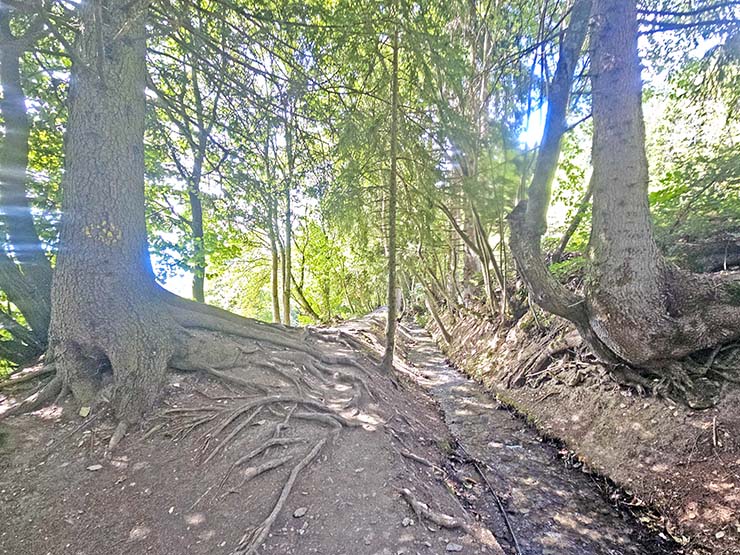
Roughly 200 meters in, you’ll briefly cross the serpentine Rte Forestière again, leaving the “unofficial parking place” on your left, and continue into a shady, peaceful forest.
The walk is pleasant, sprinkled with occasional sluice doors used to divert the bisse flow toward thirsty fields during allocated time slots. These water rights normally corresponded to the size of one’s land.
The first part of the forest path also features the Stations of the Cross. Via Crucis will bring you to Saint Marguerite Chapel, a humble Catholic sanctuary built in the early 15th century, at the same time as the bisse itself.
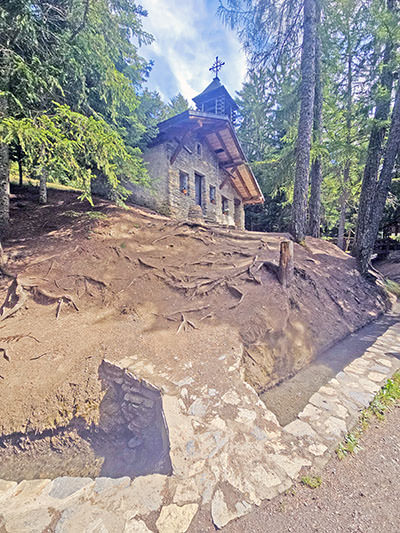
Back then, workers who constructed the irrigation canal would pray here before setting off, asking Saint Marguerite, the dragon-slaying martyr and patron saint of peasants, for a safe return. You can ask for the blessing too, while you ring the chapel’s bell.
In case the chapel’s annex room is open, you can find a moment of contemplation there – on the wall, there’s a drawing of another Saint Marguerite – Marguerite Bays, the 19th-century Swiss mystic who lived with stigmata wounds.
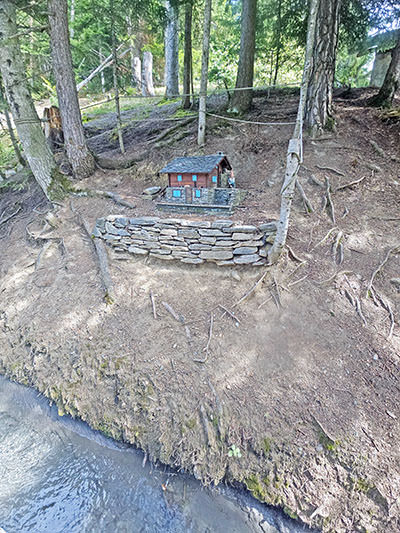
Buvette des Vouasseurs
The first-door neighbor to the chapel (if you don’t count a garden-gnome inhabited miniature chalet near the wooden waterwheel) is a refreshment stop called Buvette des Vouasseurs.
The cozy mountainside café is a scenic spot to rest and enjoy local delicacies like planchettes (traditional Swiss platters stacked with cheese, cured meats, and sausages) or gâteau Saviésan (potato-leek pie flavored with lardons and Raclette cheese). Expect to spend CHF 27-35 per dish.
In May, Buvette des Vouasseurs works only on weekends, while from June to late October it operates every day, as long as the weather conditions are good (the same applies to Bisse du Torrent Neuf).
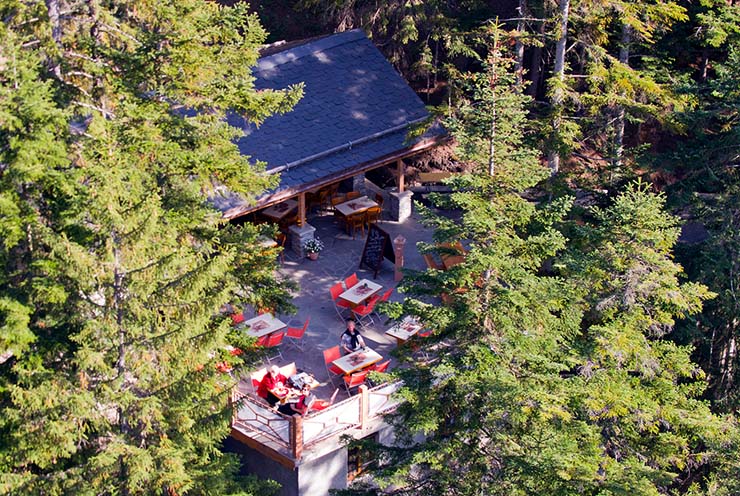
Waterfall
“Tant que l’eau coulera, l’homme vivra!” (“As long as the water flows, man will live!”), Léon Courtine famously said at the Bisse du Torrent Neuf inauguration ceremony on 22 August, 2009.
Born in 1910, this centenarian commemorated on a plaque at the start of this trail section was among the last caretakers of the original bisse system before it fell silent in 1934.
This part of the path starts with several artificial cascades. A concrete cross submerged in the streambed reveals an engraved year, 1430, acting as a cornerstone of this historic waterway that shaped the lives of local communities.
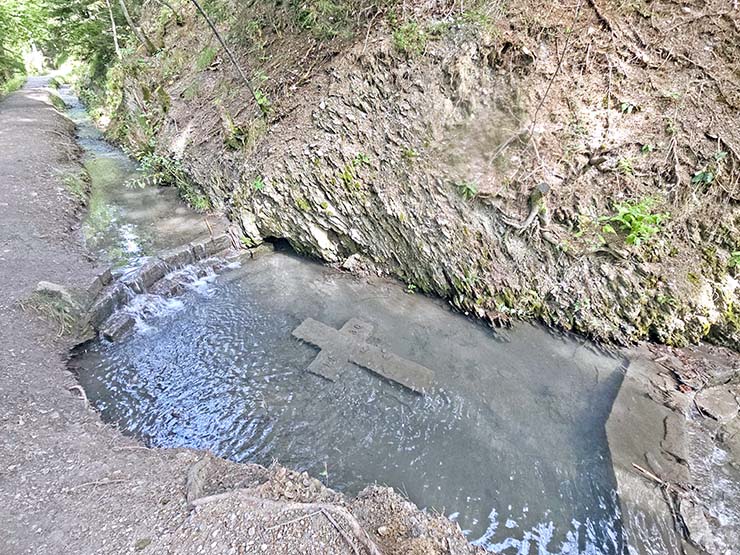
But as you walk further, the burble grows stronger, until you reach a small forest waterfall crashing down into the bisse.
Bisse du Torrent Neuf entrance gate
Soon, you’ll reach the official entrance gate of the Bisse du Torrent Neuf promenade.
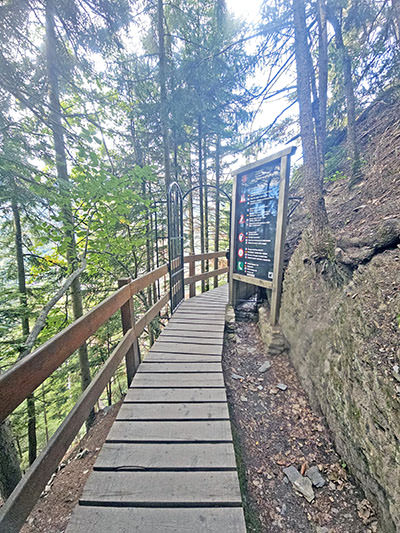
The gate is closed in winter and during rainy and windy weather. In these conditions, walking the high paths would be extremely dangerous.
As you stroll along the wooden, rocky, or soil pathway, you can explore different techniques of bisse construction, explained on a didactic panel.
Of course, if you’re not too distracted by the beautiful views of the Morge River gorge, carving its way toward the Rhône. In medieval times, this valley was the borderland between the House of Savoy and the Bishopric of Sion. These days, the river separates Savièse from Conthey.
First suspension bridge
Marked as La Chómóréta, the first suspended footbridge of the Bisse du Torrent Neuf (or Passerelle du Torrent-Neuf 1) is 87 meters long.
Constructed from metal grating for the walkway and wire mesh fencing for the railings, the bridge exposes views of the ground, 35 meters below. The steep slope, however, makes it feel even higher.
Get an impression of vibrations as you walk over the first suspension bridge in this YouTube short video!
Remember, back in the days, people didn’t have such bridges to cross the yawning void; they had to navigate the cliffs via precarious wooden planks bolted into sheer rock. With no guardrails or helmets. Don’t you feel better swaying a bit instead?
The suspension bridge is the first real test of your vertigo and faith, also a psychological turning point. If you can manage this thrilling experience surrounded by breathtaking cliffs and valleys, you’re good to commit to the rest of the route, and new pedestrian bridges coming up.
Bronze bear
The next information display will teach you about the local wildlife. But the real surprise comes around the corner, on the section named Le Mont de Chómóréta. A life-sized bronze statue of a bear (ours en bronze)!
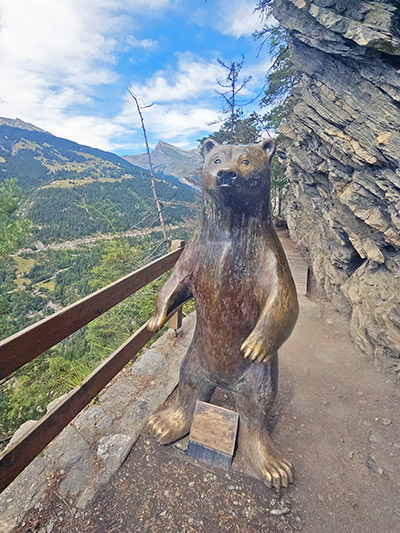
The bear stands calmly, facing out toward the vast Rhône Valley, as if contemplating the view, just like the hikers passing by.
Bears once roamed the Swiss Alps, though today they are extinct in the region. The last bear in Valais was shot in 1865, in Itravers.
Véronique Olivier’s sculpture nods to that lost wilderness and invites you to pause and reflect. Of course, taking a quirky selfie with “the guardian of the gorge” is more than welcome.
Second suspension bridge
After following the trail along the cliff edges, you’ll first arrive at a rock bridge decorated with a gigantic vintage poster. The black-and-white image from the 1930s shows workers, a priest, a woman with a headscarf, and a man with a walking stick, all balancing on narrow planks above a terrifying abyss.
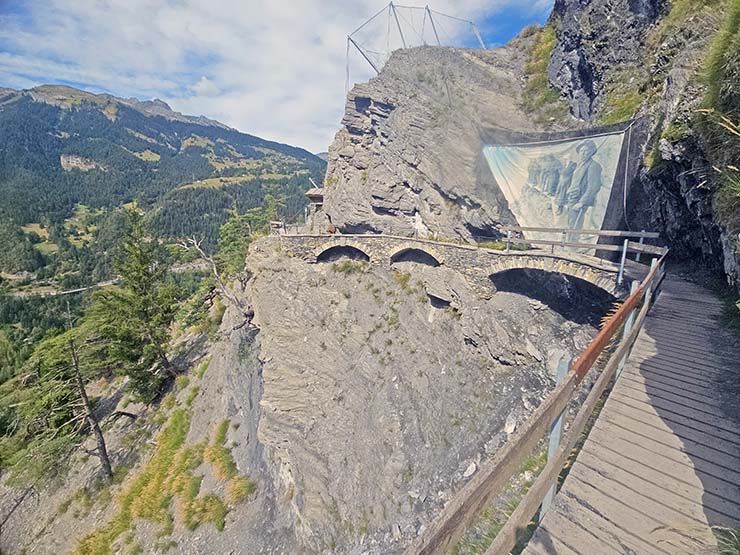
If that makes your stomach flip, you can always rest in a cozy stone-and-wood refuge (Le Mont de Barme noire) and wait here for the return of your braver hiking companions.
But if you’re ready to level up, another steel-cabled pedestrian bridge awaits, this time with side netting that should protect you from pieces of rock falling from the mountain.
The second suspension bridge (or Passerelle du Torrent-Neuf 2) is slightly longer than the first one, reaching 95 meters in length.
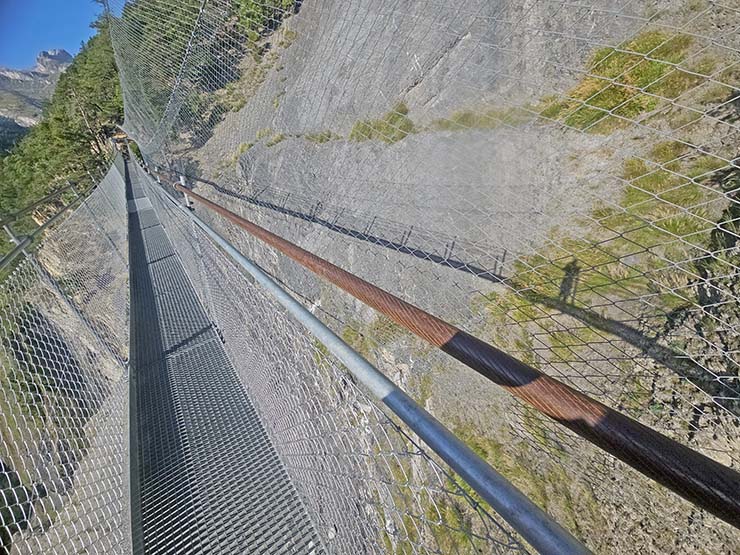
Le Couloir des Primevères panorama
As you continue your hike, the trail morphs into Le Couloir des Primevères (the Primrose Corridor), a rocky section where water spills directly over the path, cascading from the slopes above.
Soon, the path opens to a panoramic viewpoint, complete with an information board identifying the mountain peaks to the southwest – from Dent de Nendaz to Aiguille de Bérard in French Chamonix. With its 4,122 meters, Aiguille Verte, the green needle of the Mont Blanc massif, dominates the center of the image.
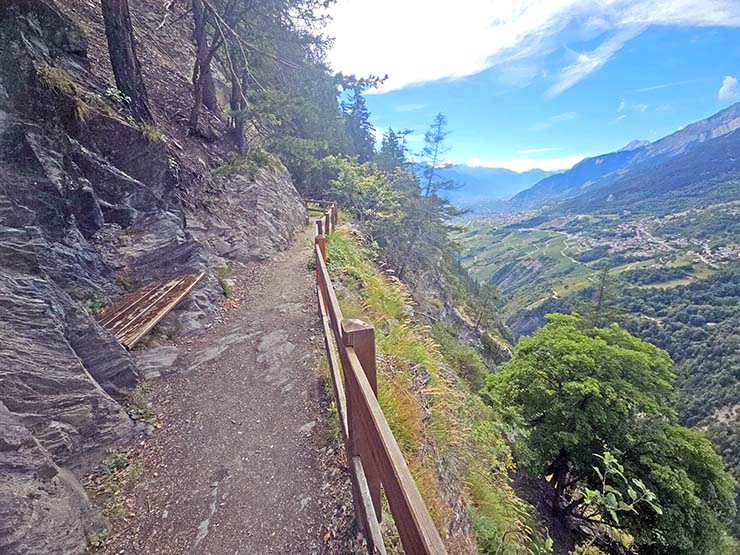
Not on the map, but right across the Morge Valley, the peaks of the Vaud Alps are visible with the naked eye. Mont Gond (2,710 m) and La Fava (2,612 m) conceal the Tsanfleuron Plateau, whose glacier meltwater feeds the Morge River.
As you continue hiking Bisse de Savièse, your northern gaze will follow the sights of Le Sublage (2,735 m) and Le Sérac (2,817 m).
Couvert du Marmouet
After crossing Le Revers du Darbelly and Couloir des Glaçons, you’ll come upon Couvert du Marmouet, a pair of wooden shelters, offering protection from the elements.
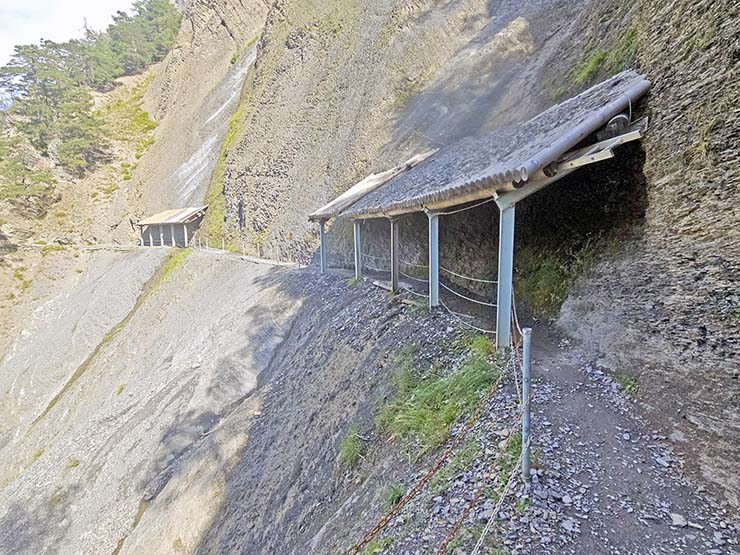
While they certainly secure no rock falls on your head, water still seeps through, its flow rinsing the rock even under these cover structures.
At the second shelter, you’ll see a plaque honoring Norbert Héritier, a 24-year-old bisse maintenance worker who tragically died in an accident here, in February 1932. Another reminder that navigating the Torrent Neuf path in winter should always be out of the question.
Third suspension bridge
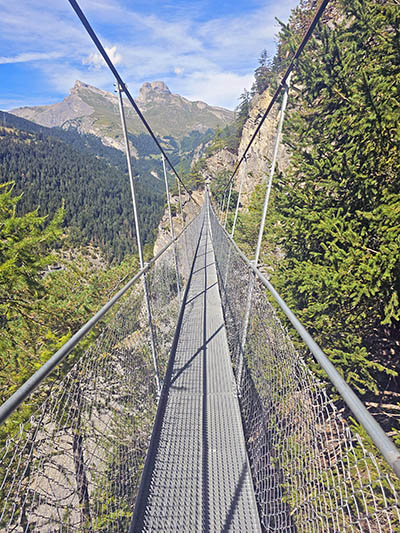
At the historic bisse section marked as Laona, the third suspension bridge (or Passerelle du Torrent-Neuf 3) stretches 97 meters, the longest of the four.
This one might be the quiet star of the trail. While the first bridge delivers the drama and the second the immersion, the third offers a blend of serenity and cinematic views.
As wind whispers into your ear, don’t zone out entirely. Glance right, and you’ll see something… odd.
Human-sized, weather-worn dolls, dressed in medieval garb, cling to the cliff. Planted at the site of the original bisse, stuck between the rock escarpments, these figures balance on wooden beams, like workers who once risked their lives, and eerily stare at the void.
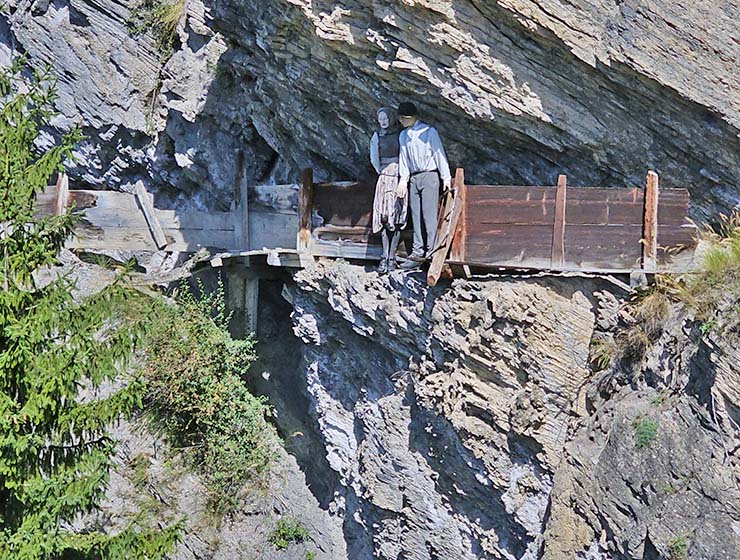
Bear’s Flume
Behind the corner, Le Mont de Laona throws a yellow warning sign with a silhouette of a bear, shouting “Danger!”.
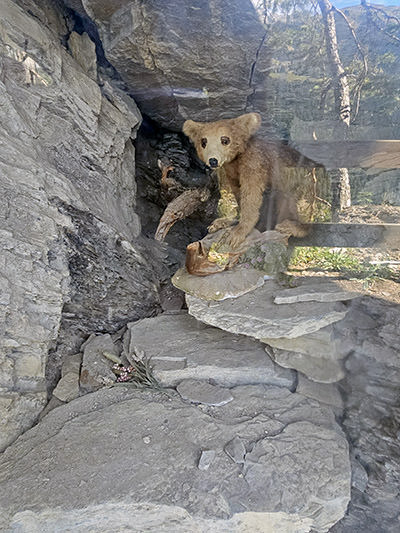
As suggested earlier, brown bears went extinct in Switzerland at the beginning of the 20th century. So, the glass and the bars, protecting a cave-like hideout of a stuffed baby bear, are here more for the bear’s safety than for ours.
Chéneau de l’Ours (Tsena dé l’O, or Bear’s Flume) is a taxidermy tableau that aimed to raise the appeal of the Torrent Neuf trail when it reopened in 2009. The original large adult bear turned out to be too appealing for some visitors. Even the protective grille couldn’t save him.
On the night of August 20, 2011, unknown vandals, or “poachers”, stole the bear. Despite a criminal complaint, the animal was never recovered.
Faced with Swiss taxidermy prices north of CHF 20,000, the Torrent-Neuf Association turned to Canada, where they sourced two replacement bears for just $500.
So if there were two substitutes, why is now only a forlorn-looking bear cub staring at you, with the saddest glass eyes in the history of taxidermy? It seems mama bear went missing again.
Chapelle Notre-Dame du Torrent-Neuf
After a smaller footbridge and a few more rockfall shelters, the cliff-hugging path brings you to the chapel of Notre-Dame du Torrent Neuf.
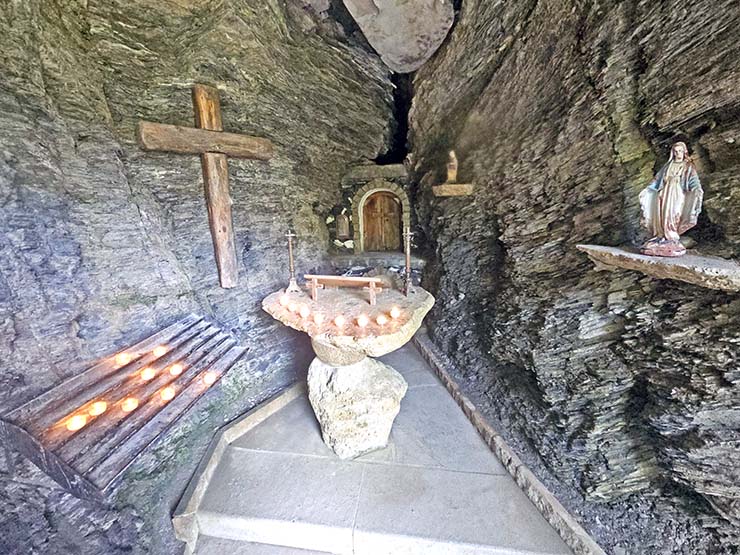
Carved directly into a rock, this small mountain chapel, adorned with stained glass, statues of the Virgin Mary, and a small bell, was built in 2011.
Light a candle, pull the wire, ring the bell, and maybe Our Lady of Torrent Neuf can provide her blessings as you continue to the final part of the dramatic bisse paysage.
Tunnel du Mougerin
Continue along the Couloir de la Chèvre (Goat Corridor), with another rustic shelter, and your next exciting bisse section will be Couloir du Mougerin.
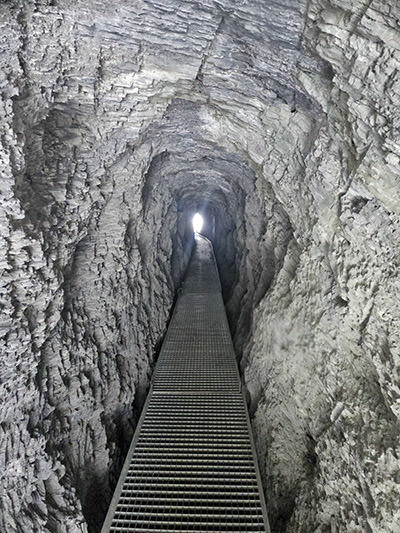
This passage running along dramatic rock faces brings you to Tunnel du Mougerin, a short man-made tunnel that enables a direct walk through the mountain.
Originally, water was following a construction on the outer side of the rounded cliff, but water forces at a sharp bend were often damaging the wooden beams (boutsets) or causing total collapse, requiring constant repairs.
A no-curve tunnel solved the issue in 1880. In its early days, one had to crawl through it, as the tunnel height was much lower than today.
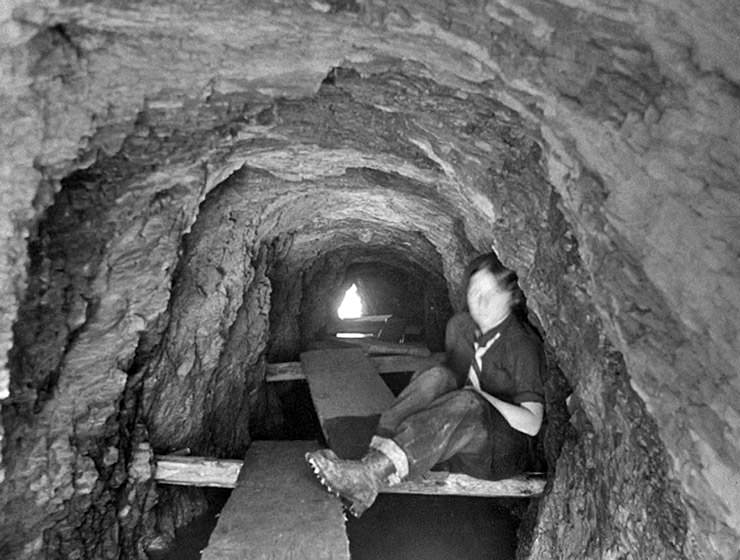
As you step out of the far end of the Tunnel du Mougerin, you’ll walk on one of the most exposed stretches of the entire Bisse du Torrent Neuf (Revers du Mougerin). Suspended high above the void, this final section feels like walking on the edge of a forgotten world, my personal favorite.
Check out this passage!
Fourth suspension bridge
After Couvert des Blancs, the final bridge crossing at the section called Travaux des Blancs is Passerelle du Torrent-Neuf 4.
At around 90 meters long, the fourth wobbly suspension bridge comes with protective side nets shielding you from wandering rocks.
Two streams of water cascade down the rocky cliffs under your footsteps: the first one is Fontana Dzéma waterfall, the other is La Fille, fed by the bisse in Revers de la Dzéma.
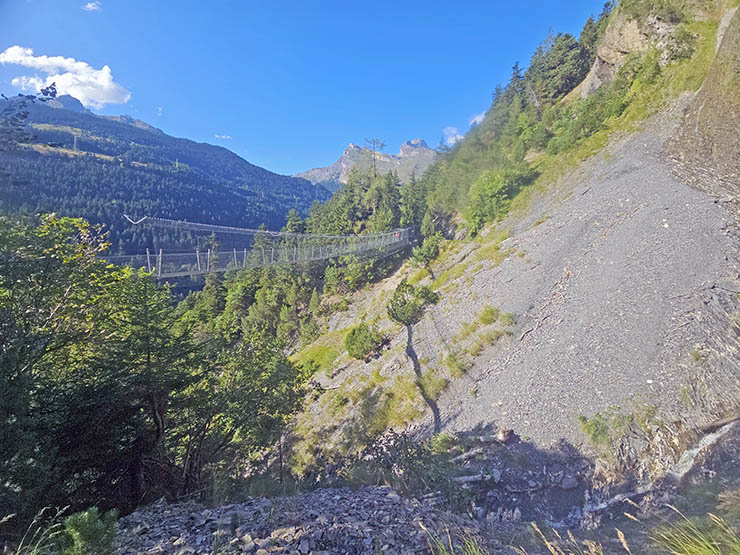
The next, final part of the Bisse du Torrent Neuf hike will lead you through the Jeur du Frène forest, with some rather calming sections (Le Débonloir, Revers du Déboyard, Les Argillets, Couloir des Argillets, Crible des Argillets, Chéneau du Frêne).
Buvette de Brac
At the end of the Bisse du Torrent Neuf hike, the Couloir de Brac finishes with a refreshment chalet, Buvette de Brac, a place to take a break.
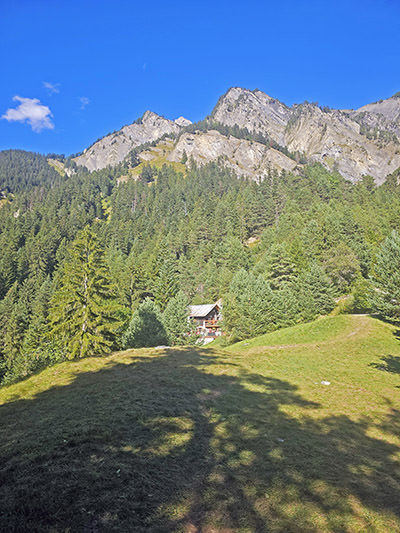
Open from late June, this traditional mountain hut is famous for its tome d’alpage alpine cheese and Valais sausages.
If you want to extend your adventure, for 5 francs, you can book a guided tour of the Branlires Wall (Paroi des Branlires), a thrilling last section of the restored hiking trail, including a stop at a water-powered sawmill (scierie).
If you’re happy to return to the trail start/finish line (which means, traversing the entire itinerary in reverse), consider sitting down at the bisse near the parking, and dipping your feet into the icy mountain water. No fish spa required, the meltwater will handle the tingling.
Feeling bougie? Groups of 10 or more can end the Bisse du Torrent Neuf experience with a helicopter ride. Call Myriam (+41 79 436 74 01) at least three days in advance, and for CHF 70 per person (about 75 euros), you’ll enjoy the royal eagle’s eye view of the trail you just conquered.
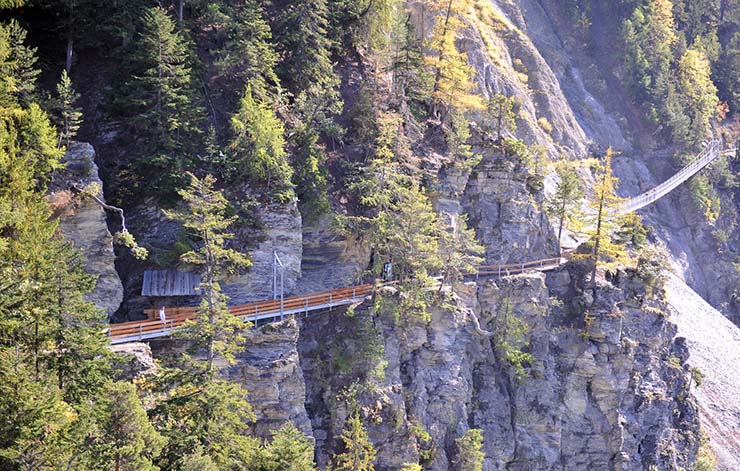
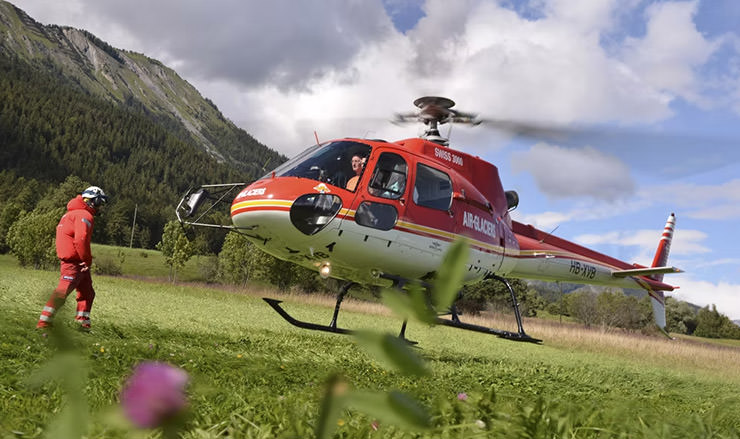
Practical tips for visiting Bisse du Torrent Neuf
If you’re planning a hike along the Bisse du Torrent Neuf, a little prep work can make a pretty big difference. Here’s what to know before you go:
What to bring to the Bisse du Torrent Neuf hike
- Sturdy hiking shoes with good grip (sections of the trail can be slippery when wet)
- Water and snacks (buvettes are not cheap)
- Sun protection (sunscreen, sunglasses, and a hat can protect you even on cloudy days)
- Phone (for photos, flashlight use, or, hopefully never needed, calling Swiss rescue at 144)
- Optional: light jacket (the weather can turn in a blink)
- Don’t bring: wheelchairs, strollers, scooters, rollerblades, skateboards, bicycles, unicycles, or anything that has wheels.
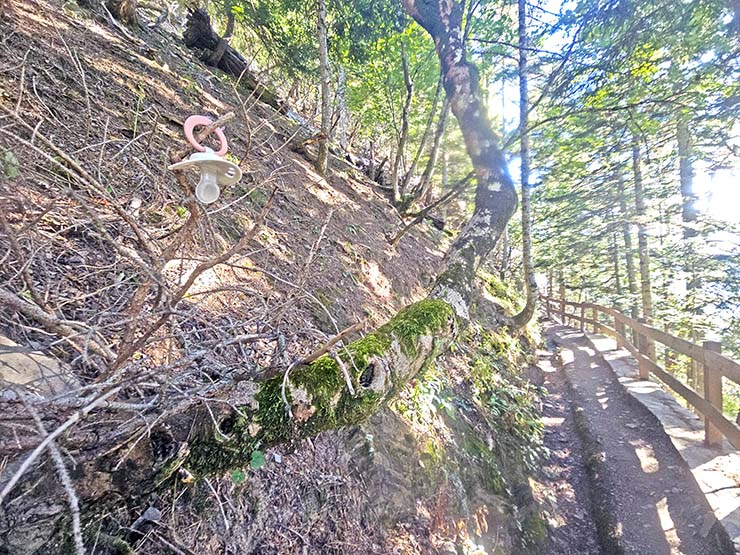
How to stay safe while hiking Bisse du Torrent Neuf
- The trail is well-maintained and fenced, but parents should keep a close eye on kids, especially near the cliffside sections. The minimum recommended age is 6.
- If you suffer from severe vertigo, Bisse du Torrent Neuf may not be your trail.
- Avoid the hike during rain or strong winds.
- Be vigilant on uphill slopes, as wildlife activity or heavy rainfall can trigger falling rocks.
- To reduce the wobble factor on suspension bridges, wait for a quiet moment. Don’t cross when large groups are on – their footfall and the wind can amplify vibrations. When your turn comes, walk steadily and hold the handrails.
- Dogs are allowed, but keep them leashed, especially on the bridges (judging by the dogs I’ve seen, they’re not fans of walking on the metal grates).
How to get to Bisse du Torrent Neuf easily
The Bisse du Torrent Neuf trailhead is located in Savièse, a scenic mountainside commune perched above Sion, the capital of Valais.
By car
From Sion, it’s a quick 15-minute drive uphill to the Prafirmin trailhead. Parking P1 in Binii (Rte de Binii-Rte des Etangs) and Parking P2 (Rte Forestière-Chem. Sainte-Marguerite) are marked on Google Maps.
Don’t have a car? Find the best rental deals in Sion via comparison platforms like DiscoverCars or Rentalcars.
By public transport
From Sion train station, hop on bus 341 or 342 to Savièse/St-Germain center (about 16 minutes). Then transfer to bus 343 heading toward Mayens-de-la-Zour. Get off at Prafirmin Torrent Neuf stop (about 13 minutes later). From here, walk 1.6 km down Chem. Sainte-Marguerite road – an easy 25-minute walk will bring you to the trailhead at P2 parking.
Things to do near Bisse du Torrent Neuf
Once you’ve crossed cliffs, tunnels, and wobbly bridges, don’t rush off just yet. The region around Savièse and Sion is full of things to see, sip, and savor.
Explore Sion
- Climb to Valère and Tourbillon castles for panoramic views. You can even do it in a company of a local.
- Wander Sion’s charming old town and sample local cuisine and wines.
- Visit the Musée d’Histoire du Valais (Valais History Museum) to dive deeper into the region’s heritage.
Wine tasting in Valais
- The area is famous for its terroir-driven wines. Don’t leave without trying Fendant, Petite Arvine, or the less-exported but highly drinkable Cornalin.
- Stop by a local cave (wine cellar) in Savièse or nearby villages for tastings.
Alternatives to Bisse du Torrent Neuf
If you’ve caught the bisse bug, here are three more scenic water canals worth a hike:
- Bisse de Clavau: Built around 1450, this bisse cuts through terraced vineyards between Sion and St-Léonard, where you can also visit Europe’s largest underground lake.
- Bisse de Mont d’Orge: Constructed in 1885, it serves Mont d’Orge Lake and the famous Mont d’Or vineyard on the southern slopes of the hill. Don’t miss the 12th-century castle ruins at the hilltop, built by the Duke of Savoy.
- Grand Bisse de Vex: Dating back to the early 15th century, this forest-shaded trail stretches 12 km from Planchouet (Nendaz) to Les Mayens-de-Sion, offering lush woodland, vineyard views, and postcard-worthy Alpine scenery.
Where to stay near Bisse du Torrent Neuf
The most convenient places to stay near the Bisse du Torrent Neuf are cozy chalets in Savièse, perfect for hikers seeking comfort after a cliffside adventure.
Le Chalet Pouchignon is the closest accommodation to the trail. This warm retreat with modern amenities offers three bedrooms, a fireplace, and a sun terrace with a Jacuzzi, ideal for soaking tired feet with a view. Check out rates for your dates on Booking or Agoda.
Chalet Mon Rêve is a little higher up the mountain, in Mayens-de-la-Zour, and it can also fit 6 guests in three rooms. Perks include an outdoor fireplace, barbecue facilities, and a pet-friendly policy. Check out rates for your dates on Booking or Agoda.
Chalet Le Raccard by Interhome is a smaller, but charming and romantic chalet for up to four people, with all the modern comforts, in a peaceful location, just next to the New Bisse Savièse restaurant. Check out rates for your dates on Booking or Agoda.
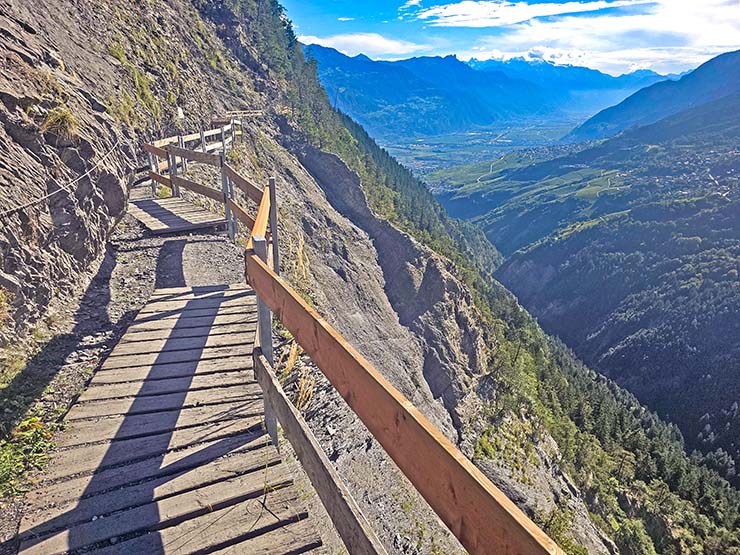
Bisse du Torrent Neuf hike – Conclusion
Before I lay down on the green grass of Brac for a well-earned rest at the final stop of my Bisse du Torrent Neuf hike, I spotted a familiar face at the buvette. There he was, that local Swiss guy I kept bumping into along the trail, sipping on a mountain tea, grinning widely. He had done it! The same man who was hesitating at the bridges had conquered them all.
I was glad to see that this picturesque trail in the Swiss Alps was more than just a physical trial. It’s a test of grit and personal boundaries, a chance to confront our fears and embrace the discomfort that often accompanies adventure.
Just like it carried life-sustaining water to medieval Savièse, Bisse du Torrent Neuf also quenches our modern thirst, as a hiking experience
I can’t help but think how stepping out of our comfort zones can lead to fulfilling discoveries. Sure, the abyss is scary. But what waits for us on the other side?
Fueled by curiosity, both my fellow hiker and I overcame far more than just anxiety-causing cliff views and not really lullabying suspension bridges.
Beyond its vertiginous stretches and dramatic rock passages, the Bisse du Torrent Neuf is a walk through history, a monument to human ingenuity, and a feast for the senses all at once.
Just like it carried life-sustaining water to medieval Savièse, this unique and exhilarating hiking experience quenches our modern thirst for connection, challenge, and awe. Every step we make over that dried bisse bed, following the half-vanished stream, makes us feel alive.
If you are after an adventurous detour from Sion, or a day immersed in alpine heritage, walking where water once flowed may just be a cultural-natural reset you didn’t know you needed.
Did you like our Bisse du Torrent Neuf hiking guide?
Pin it for later!
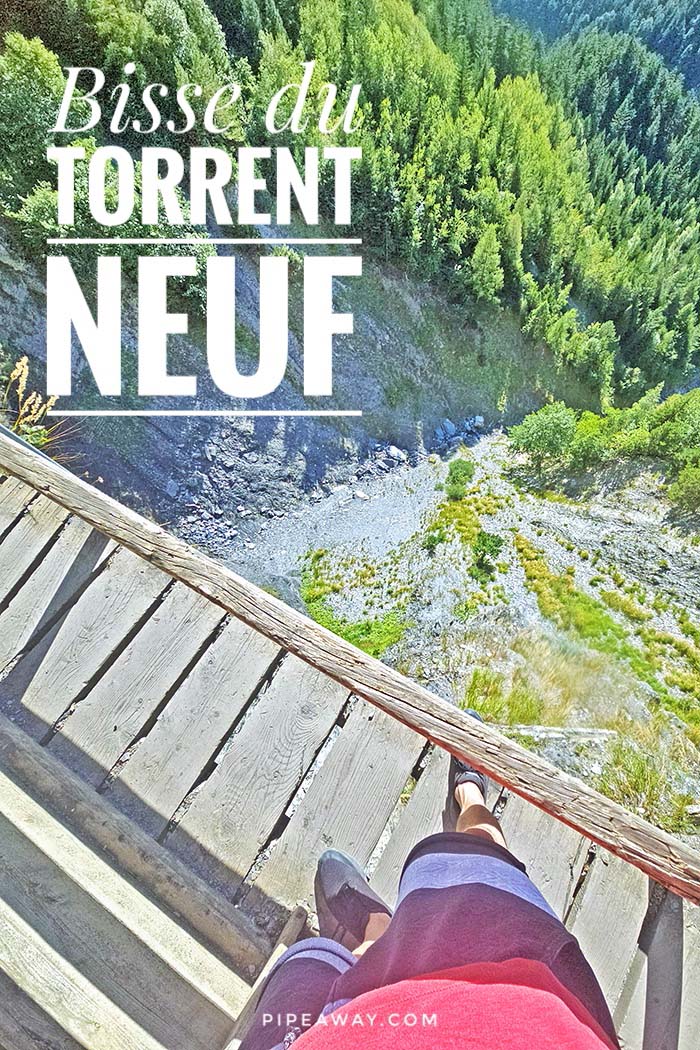
Disclosure: This post may contain affiliate links, meaning if you click on them and make a purchase, Pipeaway may make a small commission, at no additional cost to you. Thank you for supporting our work!

